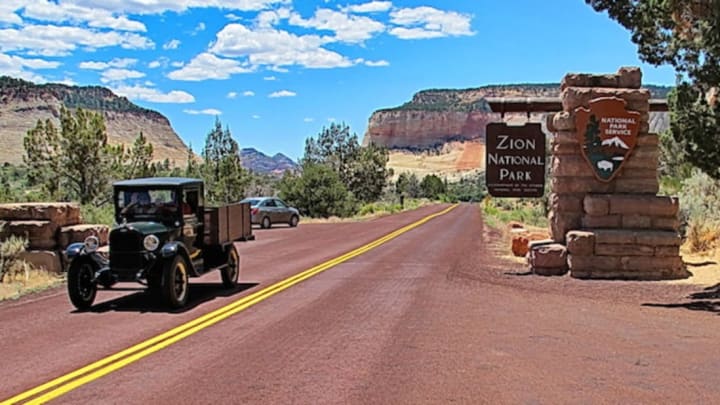10 Things You Didn't Know About Zion National Park
By Megan Snyder

is home to five national parks—including Arches, Canyonlands, Bryce Canyon, and Capitol Reef—but Zion, its first, remains the most popular. (It attracted over 3.5 million visitors last year.) Originally established as Mukuntuweap National Monument in 1909, the monument eventually became Zion National Monument in 1918, and finally Zion National Park on November 19, 1919. Throughout the park’s history, adventurous tourists have visited for the rock climbing and canyoneering, artists for the stunning landscape, and families for the hiking and ranger-led programs. Regardless of your mission, there’s a lot to love (and learn) about Zion.
1. THE HIGHWAY TO ZION WAS CREATED WITH ROAD TRIPS IN MIND.
Zion was considered a remote location when it was designated as a national monument, and its promotion to national park status 10 years later made accessibility for travelers imperative. Thus, construction of the 25-mile Zion-Mt. Carmel Highway began in 1927 and was completed by 1930. To build the road’s 1.1 mile Mt. Carmel Tunnel, workers blasted through 5613 feet of rock and added large windows for ventilation and impressive views.
2. THE CANYONS PROVIDE A SENSE OF INTRIGUE AND ADVENTURE.
Srini Sundarrajan, Flickr // CC BY-NC-SA 2.0
With locations that have eclectic names like "Refrigerator Canyon" and "The Subway," it’s difficult to choose where to hike in Zion. The numerous slot canyons turn every trip into an adventure. One of the most thrilling hikes is through The Narrows. Though this canyon along the Virgin River’s North Fork is cited as a must-see destination, most hikes there require permits—and caution. The Narrows can be incredibly dangerous for even the most skilled hiker, depending on weather conditions.
3. HIKERS CAN “WIGGLE” THEIR WAY TO THE SKY.
The sweeping views of Zion Canyon are often worth the high-elevation hikes required to get there, but some ascents are more challenging than others. One example is the trail to Angels Landing, which offers stunning views—once you’ve climbed 2.4 miles and reached an elevation of 5790 feet. To make the trek slightly easier, a series of 21 switchbacks known as Walter’s Wiggles was integrated into the trail in 1925. This section is named for Zion’s first park custodian, Walter Ruesch, who conceived the idea and helped with constructing the path [PDF].
4. THERE IS PLENTY OF PLANT LIFE (BUT NO CRYING) AT WEEPING ROCK.
Srini Sundarrajan, Flickr // CC BY-NC-SA 2.0
Despite its arid location, Zion is home to over 900 plant species. Cottonwoods, cacti, juniper trees, ponderosa pines, many wildflowers, and even aquatic plants grow throughout the park. A popular place to spot some greenery is at Weeping Rock, which was named for the groundwater seeping from the canyon wall. The water originates in Echo Canyon before springing forth from the rock, allowing ferns, mosses, and flowering plants to grow as hanging gardens on the alcove walls.
5. THE ZION SNAIL IS A "BIG FOOT" THAT IS HARD TO FIND.
Jay Sturner, Flickr // CC BY 2.0
One of the park’s few endemic creatures is the Zion snail. It is one of the smallest snails in the world, often measuring at less than ⅛ of an inch. Despite its petite stature, the Zion snail’s foot in comparison to the rest of its body is the largest in the world.
6. ZION’S BACKCOUNTRY IS A SHOWCASE FOR RED ROCKS AND ARCHES.
Andrew K. Smith, Flickr// CC BY 2.0
If you can’t make it to Arches National Park, the arches in Zion’s northern Kolob Canyons district are just as captivating. When roaming through this section, keep an eye out for the Kolob Arch, one of the world’s longest natural arches. Despite its size, Kolob tends to blend into the cliff it spans across.
7. SOME OF ZION’S MONOLITHS HAVE NAMES OF BIBLICAL PROPORTIONS.
Three large sandstone cliffs in the park make up the Court of the Patriarchs. The monoliths are named Abraham, Isaac, and Jacob—after three important figures from the Old Testament.
8. THE GREAT WHITE THRONE IS A SIGHT FIT FOR A KING.
Greg Willis, Flickr // CC BY-SA 2.0
Named in 1916 by Methodist minister Frederick Vining Fisher, the Great White Throne is considered by many to be the symbol of the park. (Fisher also named Angels Landing and the Three Patriarchs.) With an elevation of 6744 feet, the Great White Throne is easily one of the most recognizable formations and was featured on many early marketing materials for Zion.
9. A SOUGHT-AFTER ARCHITECT DESIGNED THE PARK LODGE.
Designed by Gilbert Stanley Underwood, the Zion Lodge was constructed in the mid-1920s as the only permanent lodging available on park grounds. Underwood was popular with the National Park Service: In addition to Zion Lodge, he also designed lodges for Yosemite, Grand Teton, Grand Canyon, and Bryce Canyon National Parks.
10. ZION IS THE PERFECT PLACE FOR ART LOVERS.
It should come as no surprise that Zion has inspired artists for over a century; in fact, an exhibition of Zion paintings at the 1904 World’s Fair was partly what spurred the creation of the original national monument. The love of the park’s landscapes and the art it inspires lives on in the form of an artist-in-residence program and the Zion Plein Air Art Invitational.